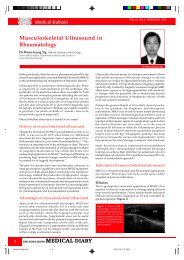MEDICAL DIARY - The Federation of Medical Societies of Hong Kong
MEDICAL DIARY - The Federation of Medical Societies of Hong Kong
MEDICAL DIARY - The Federation of Medical Societies of Hong Kong
Create successful ePaper yourself
Turn your PDF publications into a flip-book with our unique Google optimized e-Paper software.
14<br />
Introduction<br />
<strong>Medical</strong> Bulletin<br />
Reconstructive Options in Head and Neck<br />
Surgery<br />
Dr. Wai-man Ng<br />
MBBS(HK), M. Med Sc(HK), FRCSEd, FCSHK, FACS, FHKAM(Surgery)<br />
Department <strong>of</strong> Surgery, University <strong>of</strong> <strong>Hong</strong> <strong>Kong</strong> <strong>Medical</strong> Centre, Queen Mary Hospital, <strong>Hong</strong> <strong>Kong</strong><br />
<strong>The</strong> head and neck is a relatively small but densely<br />
packed bodily part, which contains many functionally<br />
important organs and structures. Besides, it is a nearly<br />
always exposed part <strong>of</strong> our body and its appearance is <strong>of</strong><br />
greatest importance for social reasons. Accordingly, the<br />
reconstructive procedures <strong>of</strong> the head and neck region<br />
should give an acceptable result in terms <strong>of</strong> both the<br />
functional and aesthetic outcomes.<br />
Aesthetic considerations<br />
As far as possible, the reconstruction should mimic the<br />
lost tissue in terms <strong>of</strong> size, shape, contour, and surface<br />
features (such as the hair distribution, skin colour and<br />
texture). Besides, the facial symmetry should be restored<br />
and the anatomical landmarks should be maintained. In<br />
addition, the ability <strong>of</strong> facial expressions is essential both<br />
aesthetically and functionally and should be preserved or<br />
restored to the degree that is possible.<br />
Functional considerations<br />
<strong>The</strong> main functions <strong>of</strong> head and neck structures include:<br />
1. Maintain patent airway and prevent aspiration<br />
2. Speech production<br />
3. Maintain oral continence and facilitate swallowing<br />
4. Protect vital structures such as airway, major blood<br />
vessels and cranial nerves<br />
5. Visual ability<br />
6. Hearing ability<br />
Many <strong>of</strong> these functions are essential for the survival and<br />
some <strong>of</strong> them are key factors in the determination <strong>of</strong> a<br />
good quality <strong>of</strong> life. 1 Preferably these structures should<br />
be preserved or restored providing the treatment <strong>of</strong> the<br />
disease condition is not being violated, while<br />
safeguarding all these mechanisms. 2, 3<br />
Diseases affecting the head and neck<br />
regions<br />
With regard to the head and neck diseases, there are two<br />
basic categories <strong>of</strong> patients that may need reconstruction:<br />
those who have congenital deformities, otherwise known<br />
as birth defects such as cleft-lip and palate, and those<br />
with developmental deformities, acquired as a result <strong>of</strong><br />
trauma, infection, neoplasm, or in some cases, aging.<br />
Different entities tend to involve different groups <strong>of</strong><br />
patients who are <strong>of</strong> different characteristics. Some<br />
VOL.12 NO.7 JULY 2007<br />
Dr. Wai -man Ng<br />
conditions are treated without the need <strong>of</strong> reconstruction<br />
while some treatments necessitate the careful<br />
preoperative planning <strong>of</strong> reconstructive choices.<br />
Choice <strong>of</strong> reconstructive methods<br />
<strong>The</strong> different kinds <strong>of</strong> defects that need reconstruction<br />
can range from small laceration to wounds that involve<br />
missing structures. <strong>The</strong> goal <strong>of</strong> the reconstruction is to<br />
restore the function and form as well as possible using a<br />
variety <strong>of</strong> surgical approaches. <strong>The</strong> surgical options are<br />
best visualised as a hierarchy <strong>of</strong> possibilities arranged in<br />
a 'reconstructive ladder'. 4-6 <strong>The</strong> successive step <strong>of</strong> the<br />
ladder is defined by the degree <strong>of</strong> complexity <strong>of</strong> the<br />
operations: primarily closure, healing by secondary<br />
intention, skin graft, local flap, pedicle flap and free flap<br />
(Table 1). In addition to the reconstructive ladder, the<br />
use <strong>of</strong> implants, tissue expansion techniques, and<br />
external prostheses are sometimes very helpful.<br />
For the majority <strong>of</strong> small defects, they can be closed by<br />
direct suture. Whereas skin grafts are <strong>of</strong>ten used to cover<br />
a bigger wound that is clean and does not have exposed<br />
raw tendon, bone, or nerve. However, skin graft will<br />
inevitably undergo various degrees <strong>of</strong> contracture, is less<br />
durable to trauma and qualitatively inferior to flaps.<br />
Furthermore skin graft cannot survive in the presence <strong>of</strong><br />
wound infection, on the irradiated tissue, and in deep<br />
seated defects.<br />
In situations where skin graft is not feasible, flaps<br />
provide a better choice <strong>of</strong> reconstruction. 'Flaps' denote<br />
repositioning <strong>of</strong> tissue that maintains some form <strong>of</strong> blood<br />
supply, and they are named for the types <strong>of</strong> tissues that<br />
are involved. Because <strong>of</strong> the robust blood supply and<br />
availability <strong>of</strong> different tissues, a flap can be designed to<br />
provide the most appropriate, suitable and durable tissue<br />
according to the defect. 'Fasciocutaneous flaps' as in<br />
deltopectoral flap consist <strong>of</strong> the skin, subcutaneous fat,<br />
and dense supportive fascia, and they are <strong>of</strong>ten<br />
preferable to skin grafts because <strong>of</strong> the better skin match<br />
and healing without excess additional scarring.<br />
'Myocutaneous flaps' such as the pectoralis major<br />
myocutaneous flap include the muscle, overlying<br />
subcutaneous tissues and skin. <strong>The</strong> muscle component<br />
provides tissue bulk to fill up any potential dead space<br />
and healthy tissues for oxygen and blood supply to<br />
combat for infection. <strong>The</strong> skin portion <strong>of</strong> myocutaneous<br />
flap is suitable for either the internal mucosal lining or<br />
external skin coverage. <strong>The</strong> vascularised bone <strong>of</strong> 'bone<br />
flaps' can replace a segment <strong>of</strong> bone loss and it gives a<br />
better successful rate for bone repair than free bone graft.
















